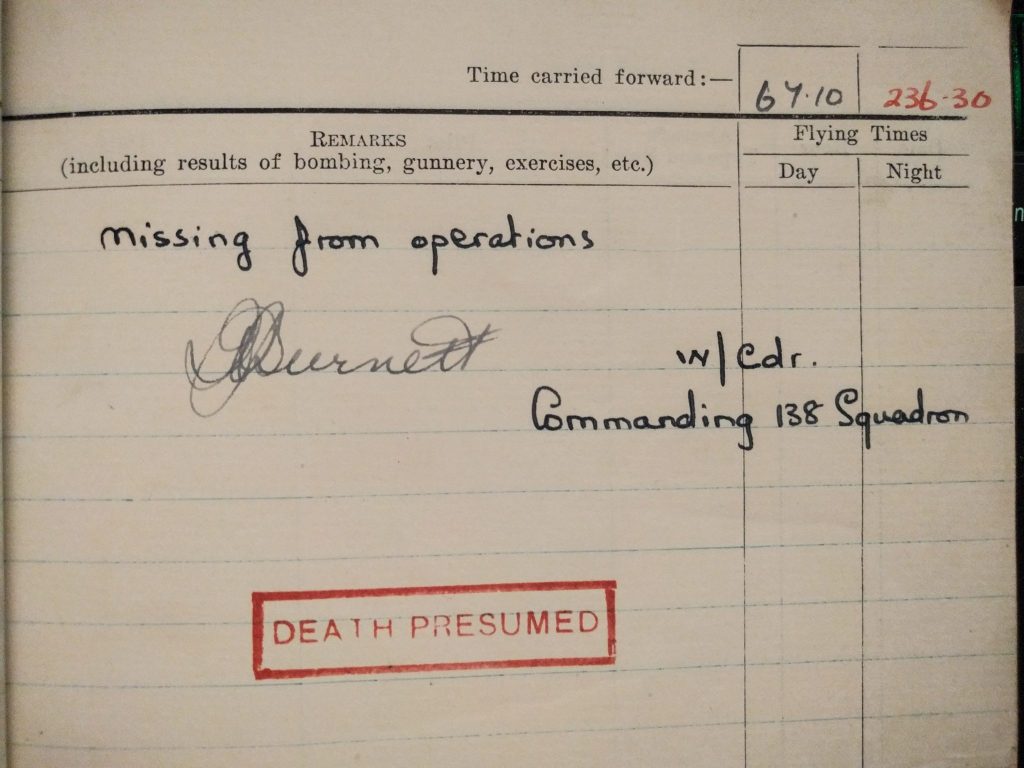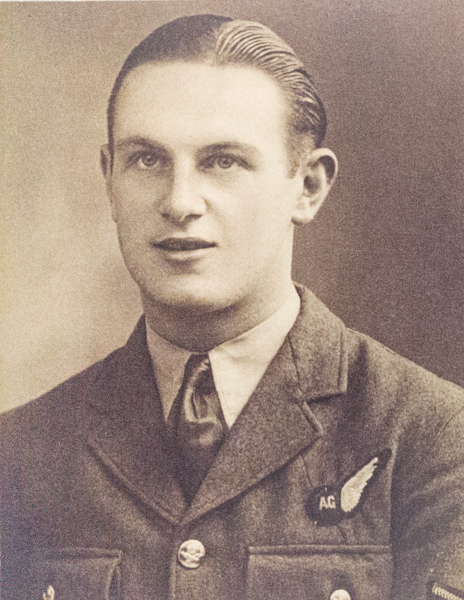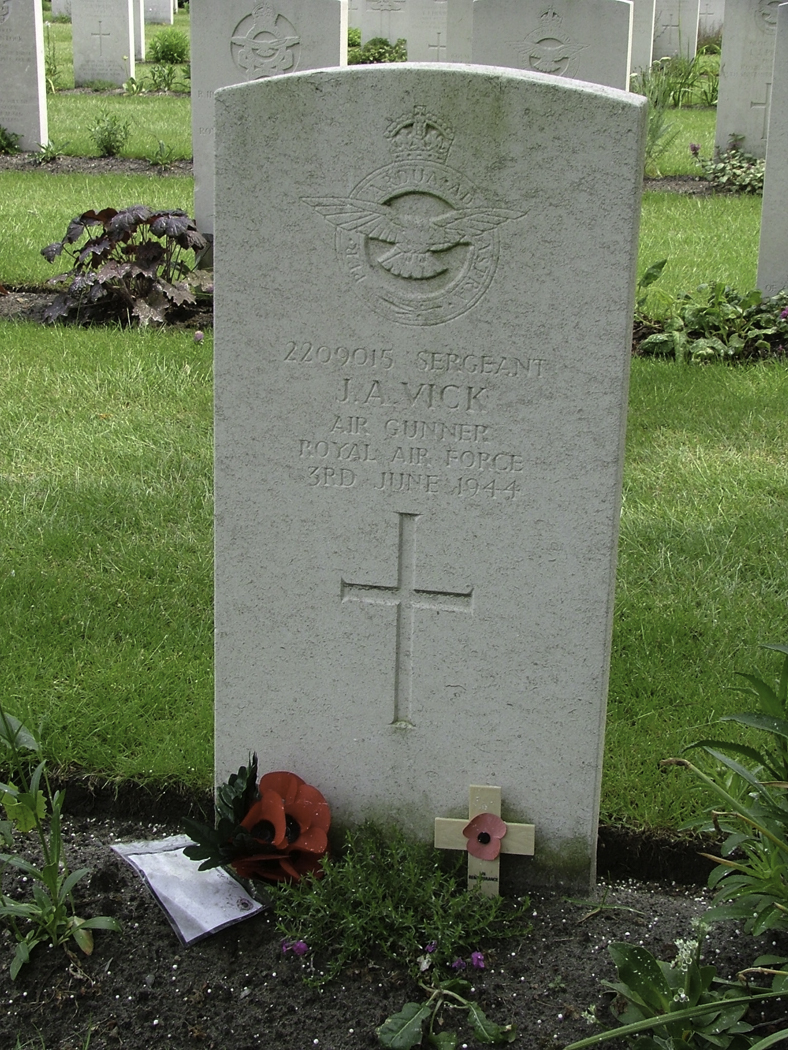John Vincent and the last flight of Halifax LL307 (NF-J)
“The noisy Halifax flies over the English Channel and tests its machine guns. Our three men, alone in the cabin because the dispatcher is taking part in the test of the armament, suddenly feel the cabin giving way beneath them. The giant airplane performs acrobatics. It’s obviously trying to evade an attack. Gaston suddenly feels slight pain in his neck. When he puts his hand there, it is to feel blood flowing from two wounds in his neck. But he doesn’t have time to think about it further. A much stronger blow, which he receives to the skull, makes him fall forward with the feeling that death is there. The plane caught fire. A piece of shrapnel crushed his right ear. His hair, which caught fire, remains in his hand when he feels the top of his head.
Fortunately the jump preparations had been made prematurely. Gaston had enough strength to jump.”
from “Gaston Masereel, un ‘père tranquille'”
My father (Johns brother) told me that by June 1944 John had finished his tour and was due to take up a post in training. As the most dangerous part of his career had ended, he had got married. The crew were then asked to fly a few more missions as “there was a put of push on” (note the date)…
On 2 June 1944 Halifax Mk V LL307 (NF-J) of 138 Squadron took off from RAF Tempsford on another mission to drop agents and equipment over occupied Europe.
The Halifax bombers used by 138 Squadron were modified and the mid turret removed to create more space – the full crew was kept as one “Air Gunner” was actually the despatcher, however it did leave the aircraft under armed.
The 7 man crew were going to drop three experienced agents over Vloesberg (Flobecq) in Western Belgium. Their mission, code name ‘Andromaque’, was to set up organizing reception committees for sabotage material and to instruct sabotage teams.
My uncle, Flight Sergeant John Vincent was the tail gunner. He was on his 32nd mission – I was told by my father (John’s brother) that, having completed 30 missions, he had been due to take up an instructor position, but, as there was “a bit of a push on” he had been asked to fly additional operations. My Uncle had only recently been married to Margaret. He had flown with same crew for many of the missions since the previous December when he had had to bail out when their plane had been unable to land due to fog. Four of that crew had perished when they landed in the sea.
Their mission on 2nd June 1944 was flown at the same time that a force of RAF Halifax and Stirling bombers were dropping mines over the Westerschelde – the Schelde River being the only access to the port of Antwerp. It could be hoped that these would provide a suitable diversion for local air defences.
At 00.40, on 3rd June, as they flew over Schouwen they were intercepted by a HE 219 night fighter piloted by Hauptman Heinz Strüning, a night fighter ace with 48 kills already recorded. (Strüning was shot down on 24/25 December 1944. He baled out but struck the tail unit of the stricken fighter and fell to his death. His body was not found until two months later.)
Despite being injured in the attack, one agent, Gaston Masereel, managed to jump and landed on the coast. He was initially captured by 4 soldiers who he overpowered and then attempted to make it back to Britain in their boat. He was captured again and taken into captivity, but survived the war.
The aircraft crashed in a flooded field called Groeneweg near Stavenisse. Partly because the area had been evacuated but also because the aircraft had been carrying agents the German authorities would not allow the bodies to be recovered from the wreckage for 3 weeks. On the 20 June locals were given permission to recover and bury the remains. They were initially buried on the edge of a local dike under a mound of garden soil as the local cemeteries were flooded. In 1948 the remains were transferred to a collective grave, Collective grave 24. A. 2-10, in the War Graves cemetery in Bergen op Zoom.
Crew of LL307:
NELSON, Eric (Wireless Operator/Air Gunner) Flight Sergeant, 183617, Royal Air Force Volunteer Reserve. Commissioned to Pilot Officer, 1077609 9th May 1944
PARRY, Eric (Flight Engineer) Sergeant 1862502, Royal Air Force Volunteer Reserve. Age 20. Son of John Owen Parry, and of Elizabeth Parry, of Upper Bangor, Caernarvonshire.
SMITH DFC, Derrick Albert John (Navigator) Flying Officer 158984 , Royal Air Force Volunteer Reserve. Husband of Elsa Smith. Awarded the Distinguished Flying Cross (DFC) – notified in the London Gazette 30 June 1944.
THOMAS, Thomas Morgan (Pilot) Flight Lieutenant 168842, Royal Air Force Volunteer Reserve. Age 31. Son of David Daniel and Charlotte Thomas from Carmarthen; husband of Rose Hannah Thomas.
VICK, James Albert (Air Gunner) Sergeant 2209015, Royal Air Force Volunteer Reserve.
VINCENT, John Keith Robert (Air Gunner) Flight Sergeant 1336764, Royal Air Force Volunteer Reserve. Age 22. Son of Dr. Leslie Jack Vincent, and of Marguerite (Rita) Vincent, of Norbury, Surrey; husband of Margaret Lewis (formerly Vincent) of Skegness, Lincolnshire.
WARBOYS, Leslie Victor (Air Bomber) Flying Officer 131987, Royal Air Force Volunteer Reserve.
Agents:
FILOT, Henri (SOE Agent) Sergeant, Belgian Army. Age 29.
STROOBANTS, Louis (SOE Agent) Sergeant, Belgian Army. Age 29.
MASEREEL, Gaston (SOE Agent). Age 37. Survived crash. His story is told in the link below.
After the war Gaston Masereel and Johns mother exchanged letters.
On 3 June 2004 we made a visit to the cemetery.
Unfortunately we don’t have a picture of the crew or aircraft that were lost on 3 June 1944.

I cannot guarantee that the information included in the external links is accurate but I have no reason to doubt any of them. Google Translate was used to translate information where required.
➡ Gaston Masereel, un ”père tranquille” His story of becoming an agent, being shotv down and captured. (In French)
➡ Wings to Victory World War Two Museum, specialized in the air war over southwestern Holland (In Dutch and English)
➡ Wings to Victory details of the crash (in Dutch)
➡ Wings to Victory PDF with further details of the crash and recovery of bodies (in Dutch and German)
➡ RAF Commands – Crash details
➡ TEMPSFORD, RAF Personnel Losses – Roll of Honour
➡ Aces of the Luftwaffe – Heinz Strüning He was flying in a Heinkel 219 of 3./NJG 1
Book:
Gedenkboek Inlichtings- en Actie Agenten
(Memorial Volume Intelligence and Action Agents)
edited by Roger Baron Coekelbergs, Marc Cools, Robin Libert, Veerle Pashley, Jaak Raes, David Stans, Renaat Vandecasteele
Antwerpen : Maklu, 2015.
These translations were used in the writing of this page:
- LL307 – Translation of pages relating to the surviving agent
- LL307 – Mystery of the Missing War Aviators Remains
This is a work in progress and will be added to as I gather more information.
Last updated 13 May 2022


